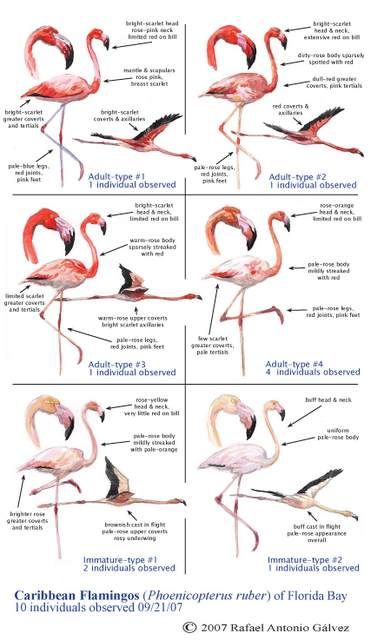
[ Follow Ups ] [ Post Followup ] [ TAS BirdBoard ] [ FAQ ]
Posted by Rafael Galvez on 15:36:43 09/23/07

On Friday September 21, I set out on a kayak with the intent of studying closely the recently-sighted flock of Caribbean Flamingos in the general vicinity of Snake Bight. Despite what the popular lists may say, I prefer using the name Caribbean (or American) Flamingo in light of the recent split between the Old World Greater Flamingo (Phoenicopterus roseus), and its Neotropical counterpart, our own P. ruber (see Knox et al. 2002).
Reports within the last 2 weeks on the number of flamingos in the Snake Bight vicinity have been varying from as many as a dozen birds, to less than five. Considering the propensity flamingos have for foraging together despite the inconsistent number of birds recently sighted, and the scarcity of these birds within recent years, I thought it important to better understand our current flock.
The flock was first sighted at around 8:45am near Gibby Point, east of Christian Point. The flock consisted of 10 individuals of varying appearance. Here I have included schematics of the individual types. Despite the overall pale appearance of the flock as a whole, most individuals were birds 2 years or older into maturity. Despite the very pale coloration of a few of the individuals, all the birds wear the tell-tale marks of typical Caribbean P. ruber flamingos:
3 of the individuals fit the description of immature birds, possibly on their second-year plumage. It should be noted that accurate ageing of Caribbean flamingos before their fourth year of maturity can be very difficult due to varying food sources and habits.
4 of the adult birds had primarily pale-rose colored bodies, with brighter streaking throughout, and redder heads and necks.
2 birds were adults with prominent red on their bills, and scarlet on the head, neck, and flight feathers.
1 adult flamingo had bright-scarlet flight feathers, head, and neck, but a paler body. This individual had bluer legs, and was of a slightly more compact proportion than the others (this can be true of females).
Perhaps this last brighter adult most approximated the appearance of the flamingo sighted at the Cutler Wetlands this July of 07; that bird however, was more uniformly colored than any of the adult flamingos in the current FL Bay flock.
It should be noted that none of the birds wore bands or tags of any sort, and that the presence of bands on flamingos does not necessarily connote captivity. On the contrary; the sole flamingo in the Everglades whose origin has been fully traced (within recent time) was the banded "DFJV" flamingo photographed by many. "DFJV" had been banded as a fledgling in Mexico in 2000, and was sighted in the Everglades as a brightly colored adult in late 2002. All of the many adult birds that accompanied DFJV in 2002 were more brightly colored overall than the brightest adult currently in Florida Bay; none seemed as uniformly colored as the Cutler Wetlands bird of this July.
I trailed behind the birds throughout the day. They waded primarily in deep water, mostly preening but never feed-walking or stomping. On kayak, the birds were approachable and never weary of my proximity although I was as close as 20 feet from them. I followed them for stops at Porpoise Point in Snake Bight, and 3/4 east between Gibby and Porpoise Points (where they have been continually sighted).
My goal was to obtain feathers from these birds (without disturbing them!!) for DNA analysis. I was able to obtain 7 contour feathers that the birds dropped while preening.
Anyone seriously interested in taking part in DNA analysis of these feathers please contact me directly.
Please also contact me directly if you get sight of any individual flamingos in the Snake Bight area that fit the profile of the birds described above.
Thanks
Rafael A. Galvez
[ Follow Ups ] [ Post Followup ] [ TAS BirdBoard ] [ FAQ ]